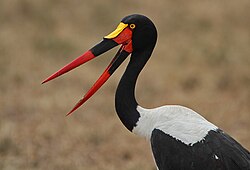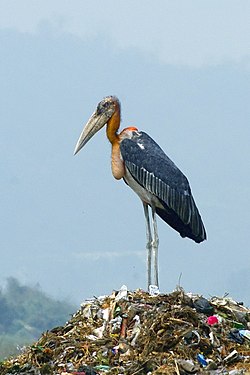| Common name | Binomial name | Population | Status | Trend | Notes | Image |
|---|
| Storm's stork | Ciconia stormi | 400-500 [1] | EN [1] |  [1] [1] | Equal to 260-330 mature individuals. Based on estimates of 150 individuals in Malaysia, and 250 in Indonesia. [1] |  |
| Saddlebill | Ephippiorhynchus senegalensis | 1,000-25,000 [2] | LC [2] |  [2] [2] | Equal to 670-17,000 mature individuals. [2] |  |
| Greater adjutant | Leptoptilos dubius | 1,200-1,800 [3] | NT [3] |  [3] [3] | Equal to 800-1,200 mature individuals. Estimate based on estimates of 650-800 birds in Assam, India, 150-200 in Cambodia, and 156 in Bihar state, India. [3] |  |
| Milky stork | Mycteria cinerea | 2,200 [4] | EN [4] |  [4] [4] | Equal to 1,500 mature individuals. [4] |  |
| Oriental stork | Ciconia boyciana | 1,000-2,499 [5] | EN [5] |  [5] [5] | Estimate for mature individuals. [5] |  |
| Lesser adjutant | Leptoptilos javanicus | 8,000-15,000 [6] | NT [6] |  [6] [6] | Equal to 5,500-10,000 mature individuals. [6] |  |
| African woollyneck | Ciconia microscelis | 10,000-100,000 [7] | LC [7] |  [7] [7] | |  |
| Jabiru | Jabiru mycteria | 20,000-85,000 [8] | LC [8] | Unknown [8] | Estimate for mature individuals. Another estimate has been made that places the population at fewer than 50,000 mature individuals. [8] |  |
| Black-necked stork | Ephippiorhynchus asiaticus | 15,000-35,000 [9] | NT [9] |  [9] [9] | Conservative range. [9] |  |
| Black stork | Ciconia nigra | 24,000-44,000 [10] | LC [10] | Unknown [10] | European subpopulation estimated at 19,500-27,800 mature individuals. [10] |  |
| Painted stork | Mycteria leucocephala | 25,000-35,000 [11] | NT [11] |  [11] [11] | Equal to 16,000-24,000 mature individuals. [11] |  |
| Asian woollyneck | Ciconia episcopus | 50,000-249,999 [12] | NT [12] |  [12] [12] | Precautionary estimate for mature individuals. [12] |  |
| African openbill | Anastomus lamelligerus | 300,000-500,000 [13] | LC [13] |  [13] [13] | |  |
| White stork | Ciconia ciconia | 700,000-704,000 [14] | LC [14] |  [14] [14] | European subpopulation estimated at 447,000-495,000 mature individuals. [14] |  |
|











